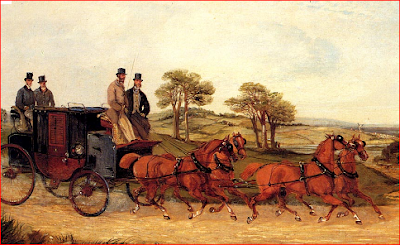Sometimes I forget that the world of the people I've been reading and writing about existed almost 200 years ago and would be unrecognizable to us today.
Patrick Edward Reilly was born 217 years ago .........
I don't have to tell you how much the world has changed in that time. But, I don't think of those differences very often.j
Take our postal service and mail delivery.
Did you ever wonder HOW exactly Henry Patrick managed to communicate between his law office in Dublin and his office on the opposite side of the country in Ennistymon?
The answer is ~ Mail Coach.
Mail coaches were usually drawn by four horses and accommodated four passengers inside and three passengers outside.
One American passenger claimed that the inside of the mail coach was “incommodious … the seats being small and very insecure,” but it may have been worse if you rode outside.
"Outside riders could not sleep and dust was their constant companion."
As for the mail, it was secured by lock and key at the rear of the coach in a mail box and guarded by a Royal Mail Post Office Guard who was armed with a pistol and followed strict rules that were “sternly enforced … [with] no exception.”
The mail coach was faster than the stage coach as it only stopped for the delivery of mail and to change horses.
They had priority on the road and all other road users were obliged by law to keep out of their way.
They did not have to stop at toll-gates and, as they approached, the guard would play a vigorous tune on his horn to alert the toll-keeper so he could have the toll-gate standing open.
A similar tune was played on the approach to an inn where a fresh team of horses should be waiting.
Mail Coaches were very fast but also very dangerous and very expensive for passengers.
As the mail coaches thundered down the turnpikes, they had to keep a sharp eye out for dangerous items in their path.
In their heyday, there was nothing faster than a mail coach.
Those who traveled on them or witnessed them speeding by could never forget the excitement attached to them.
One person captured the thrill of riding in a mail coach:
“Like fire racing along a train of gunpowder … A fiery arrow … let loose, … we are seen from every storey [sic] of every house. Heads of every age crowd to the windows … and rolling volleys of sympathising cheers run along us, behind, and before us.”
For those who rode in these flying mail coaches, it was an experience not soon to be forgotten.
As mentioned, however, riding in a mail coach in the 1850s could be a very dangerous experience........
The roads were just cart tracks, and as long as Ireland was an agricultural country and people seldom moved far from their villages, cart tracks were all that were required.
So the state of the roads was not a matter of concern.
Needless to say, there were accidents. The commonest causes were poor weather, fast driving and drunkenness.
Mail Coach Drivers were renowned for swearing and for drunkenness. If a coach did break down, the instructions were, 1st class keep your seat, 2nd class, get down and walk, 3rd class get down and push!
The Mail Coach always traveled at medium to high speeds and passengers chose this means of travel for that benefit and definitely not for comfort.
They were only marginally more comfortable than Stage Coaches which just carried passengers.
Stage Coaches were often very crowded and they travelled at a more sedate speed.
On September 9, 1851, our great great grandfather, Patrick Edward Reilly Esq, was involved in a Mail Coach Accident.
They were passing the town of Tuam when the horses must have been spooked and took off!
Their "traces" (which helped control the team) broke and the horses ran off.
P E was seriously injured when he was thrown from the coach.
This story appeared in every newspaper from Ennistymon to London and beyond!!
This story appeared in every newspaper from Ennistymon to London and beyond!!
I wonder how PE was transported to a doctor after the accident and how long it took him to recover.
Isn't it amazing to have found such a tidbit of information about an ancestor of ours who had lived over two centuries ago!
Isn't it amazing to have found such a tidbit of information about an ancestor of ours who had lived over two centuries ago!
The introduction of the Railway System marked the demise of the Mail Coach.
EPILOGUE
History gives a nation its bearing on what it is and how its people are affected by what has happened in the past.
Its kings and queens, its wars - with victories and defeats - these all mold a nation’s culture into the way it views itself in the present.
In the same way, a family history presents how a family has survived and come to terms with the great social and cultural experiences of the ages.
We hope these stories will give each member of our family a foundation and, in some small way, explain how we came to be what we are today.
Hopefully, through these vignettes, our future generations will gain a knowledge of the energy and dynamism, the loves and hates, the errors and mistakes, the victories and failures, the struggles and successes that make us what we are.
Our family history presents a fascinating read - and, hopefully, some lessons to be learned in the process.












No comments:
Post a Comment